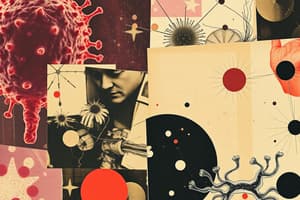Podcast
Questions and Answers
What is the primary function of the Membrane Attack Complex (MAC)?
What is the primary function of the Membrane Attack Complex (MAC)?
- Activating mast cell degranulation
- Presenting antigens to T-cells
- Destroying pathogens by forming a membrane-bound channel (correct)
- Recruiting neutrophils to the site of infection
Which of the following molecules is NOT involved in attracting cells to the site of infection?
Which of the following molecules is NOT involved in attracting cells to the site of infection?
- C3b (correct)
- C4a
- C3a
- C5a
What is the primary function of dendritic cells in the immune response?
What is the primary function of dendritic cells in the immune response?
- Activating the complement system
- Presenting antigens to T-cells (correct)
- Releasing pro-inflammatory cytokines
- Phagocytosing pathogens
Which cells are activated by C3a and C5a to undergo degranulation?
Which cells are activated by C3a and C5a to undergo degranulation?
What is the primary mechanism by which macrophages recognize pathogens and activate the innate immune system?
What is the primary mechanism by which macrophages recognize pathogens and activate the innate immune system?
What is the consequence of cytokines initiating an inflammatory response?
What is the consequence of cytokines initiating an inflammatory response?
Which of the following cytokines is responsible for simulating the liver to produce acute phase proteins?
Which of the following cytokines is responsible for simulating the liver to produce acute phase proteins?
What is the function of natural killer cells in the immune response?
What is the function of natural killer cells in the immune response?
What is the consequence of interferons inhibiting viral entry and replication?
What is the consequence of interferons inhibiting viral entry and replication?
What is the role of monocytes in the immune response?
What is the role of monocytes in the immune response?
What is the consequence of IL-1 being released during the acute phase response?
What is the consequence of IL-1 being released during the acute phase response?
Flashcards are hidden until you start studying
Study Notes
Complement System Activation
- The complement system is activated by the presence of pathogens, leading to the destruction of the pathogen through the formation of the Membrane Attack Complex.
- C3b, a product of the complement system, acts as an opsonin, marking pathogens for destruction by immune cells.
Chemotaxis and Cell Activation
- C5a, a complement system component, attracts immune cells, including neutrophils, monocytes, and eosinophils, to the site of infection.
- C3a, C4a, and C5a activate mast cell degranulation, releasing histamine and other mediators.
- C3a and C5a also activate eosinophil degranulation, contributing to the inflammatory response.
Innate Immune System Activation
- Macrophages recognize pathogens and activate the innate immune system, triggering a rapid response to infection.
- Dendritic cells, upon recognizing pathogens, pick up antigens and migrate to activate the specific immune system, leading to a targeted response to infection.
Macrophage Activation
- Macrophages recognise pathogens and initiate phagocytosis
- Release cytokines and interferons as immune responses
- Interferons inhibit viral entry and replication within cells
Cytokine Functions
- Cytokines recruit help by activating monocytes to become macrophages
- Cytokines initiate an inflammatory response, leading to:
- Vasodilation
- Increased vascular permeability
- Localised endothelial cell activation
- Cytokines activate other systems, including:
- Mast-cell degranulation
- Clotting system activation
- Kinin system
Inflammatory Response and Acute Phase Response
- Inflammation leads to an acute phase response, characterised by:
- Macrophages and neutrophils secreting more cytokines, including interleukins
- Interleukins have various functions, including:
- IL-1: causing fever, lethargy, and anorexia
- IL-6: stimulating the liver to produce acute phase proteins (opsonins)
- IL-8: recruiting and activating neutrophils
- IL-2 and IL-12: activating natural killer cells
Natural Killer Cells
- Natural killer cells are recruited to tissues and:
- Kill virally infected cells (and tumour cells)
- Produce interferon-gamma (IFN-γ) that further stimulates macrophages
Studying That Suits You
Use AI to generate personalized quizzes and flashcards to suit your learning preferences.





